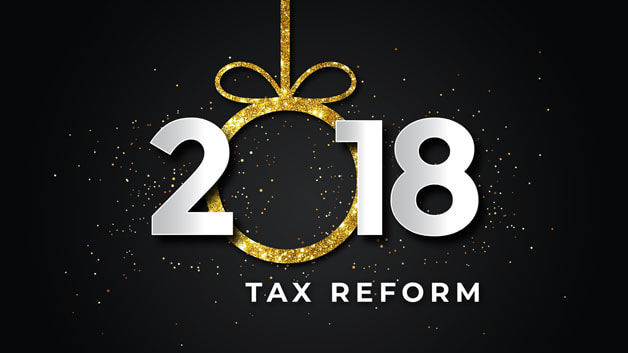New Withholding TablesIn the Tax Cuts and Jobs Act (TCJA) passed in late December, the IRS released new income tax withholding tables that reflect the changes to the tax bracket structure. Employers will have until February 15 to update their payroll systems to reflect the new changes, and employees will start seeing the changes in their paychecks after that point. The TCJA reduces income tax rates for nearly all taxpayers. Extensive tax changes like this rarely happen, so it’s worth keeping an eye on your pay stubs over the next few weeks. The danger is that if the changes aren’t done right, you’ll either have too much tax taken out every paycheck, or end up with a large tax bill because too little was withheld. Here are some tips: Make Sure the Changes Are MadeIf you are an employee, you’ll want to ensure that the withholding changes are completed by February 15. Most people will see their paychecks increase slightly. If there’s no change, or if your paycheck decreases, take a closer look and talk to your employer to find out why. These changes do not require you to file a new Form W-4 if you already have one on file with your employer. If you are an employer, the IRS said in a notice that all employers “should begin using the 2018 withholding tables as soon as possible, but not later than Feb. 15.” The updated withholding tables are available on the IRS website. Check the Withholding CalculatorThe IRS has said it will update its online withholding calculator tool by late February. Make a note to check this tool during early March to see whether your paychecks are correct. The tool will ask you to enter information including your income, tax status, and paycheck frequency. The calculator will generate an estimate of what your paychecks should look like under the new tax laws. Periodically Double-CheckIf your tax situation is more complex than the norm, it’s possible that you may end up under-withholding taxes from your paycheck, even if things look correct earlier in the year. This is particularly true if you itemize your deductions on your tax return, have multiple jobs, or change jobs during the year. If you compare your pay stubs with the withholding calculator again mid-year, that should still give you enough time to correct your situation if things have gone off track.
Sweeping tax law changes almost always trigger corresponding changes to employee withholdings, and the 2018 changes created by the TCJA are no different. If you have any questions regarding your situation, don't hesitate to call.
1 Comment
For one reason or another, you may find yourself in a situation where you've lost track of a retirement account like a 401(k) or pension.
There are several ways this can happen:
Luckily, there are several handy but little-known ways to retrieve retirement account information:
Once you've located a lost retirement account, you can roll it over into an IRA if it's yours, or you can take several approaches if it is an inherited asset. Reach out if you'd like to discuss your options regarding tax-advantaged retirement accounts. Getting audited by the IRS is no fun. Some taxpayers are selected for random audits every year, but the chances of that happening to you are very small. You are much more likely to fall under the IRS's gaze if you make one of several common mistakes. That means your best chance of avoiding an audit is by doing things to prepare right before you file your return this year. Here are some suggestions:
Don't leave anything out. Missing or incomplete information on your return will trigger an audit letter automatically, since the IRS gets copies of the same tax forms (such as W-2s and 1099s) that you do. Double-check your numbers. Bad math will get you audited. People often make calculation errors when they do their returns, especially if they do them without assistance. In 2016, the IRS sent out more than 1.6 million examination letters correcting math errors. The most frequent errors occurred in people's calculation of their amount of tax due, as well as the number of exemptions and deductions they claimed. Don't stand out. The IRS takes a closer look at business expenses, charitable donations and high-value itemized deductions. IRS computers reference statistical data on which amounts of these items are typical for various professions and income levels. If what you are claiming is significantly different from what is typical, it may be flagged for review. Have your documentation in order. Be meticulous about your recordkeeping. Items that will support the tax breaks you take include: cancelled checks, receipts, credit card and investment statements, logs for mileage and business meals and proof of charitable donations. With proper documentation, a correspondence letter from the IRS inquiring about a particular deduction can be quickly resolved before it turns into a full-blown audit. Remember, the average person has a less than one percent chance of being audited. If you prepare now, you can narrow your audit chances even further and rest easy after you've filed. As the tax filing season approaches, it's time to start thinking about who will prepare your state and federal tax returns.
In 2017, more than 132 million individual and family tax returns were e-filed, the most accurate, safest, and easiest way to file. More than 16 million were prepared on a computer and printed or prepared by hand, then mailed. The IRS stresses that no matter who prepares a federal tax return, by signing the return, the taxpayer becomes legally responsible for the accuracy of all information included. Many taxpayers pay for tax return preparation. By law, all paid tax preparers must have a Preparer Tax Identification Number, or PTIN. Paid preparers must sign the return and include their PTIN. The IRS offers tips to help taxpayers choose a tax return preparer wisely. The Choosing a Tax Professional page has information about tax preparer credentials and qualifications. The IRS Directory of Federal Tax Return Preparers with Credentials and Select Qualifications can help identify many preparers by type of credential or qualification. Taxpayers who use paid preparers should still keep copies of their most recent tax returns for their own records. If using a software product for the first time, you may need your adjusted gross income amount from your prior-year return to verify your identity. Always avoid fly-by-night preparers who may not be available after the due date or who base their fees on a percentage of the refund. The Internal Revenue Service announced yesterday that it will begin accepting tax returns on Monday, Jan. 29, 2018. Nearly 155 million individual tax returns are expected to be filed in 2018. The nation’s tax deadline will be April 17 this year – so taxpayers will have two additional days to file beyond April 15.
Many software companies and tax professionals will be accepting tax returns before Jan. 29 and then will submit the returns when IRS systems open. Although the IRS will begin accepting both electronic and paper tax returns Jan. 29, paper returns will begin processing later in mid-February as system updates continue. The IRS strongly encourages people to file their tax returns electronically for faster refunds. The IRS set the Jan. 29 opening date to ensure the security and readiness of key tax processing systems in advance of the opening and to assess the potential impact of tax legislation on 2017 tax returns. Congress has passed tax reform that will take effect in 2018, ushering in some of the most significant tax changes in three decades. Here are some of the most important items in the new bill that impact individual taxpayers. Individual Rule Changes
Because major tax reform like this is so rare, it's worth scheduling a tax planning consultation to ensure you get the most tax savings possible during 2018. Click here to contact Ellsworth & Associates and set up an appointment. If you have not already done so, now is the time to review your tax situation and make an estimated quarterly tax payment using Form 1040-ES. The fourth-quarter due date is now here.
Normal due date: Tuesday, January 16, 2018 Remember, you are required to withhold at least 90 percent of your current tax obligation or 100 percent of last year’s federal tax obligation.* A quick look at last year’s tax return and a projection of this year’s obligation can help determine if a payment is necessary. Here are some other things to consider:
*If your income is over $150,000 ($75,000 if married filing separate), you must pay 110% of last year’s tax obligation to be safe from an underpayment penalty. Inheriting a retirement account like a 401(k) or an IRA is more complicated tax-wise than if you’d been left a house or a set of golf clubs. Here are some tips on how to use a “stretch out” to avoid being hit with a big tax bill. Stretching It OutA stretch out is a plan to start taking small distributions from an inherited retirement account over a period of time. It allows a person who inherits a retirement account to avoid paying income tax on the entire amount right away. Taxpayers also benefit by keeping the account as a tax-advantaged investment vehicle that can grow over time. Example: Dee Lee Beloved, 30 years old, inherits a $1 million IRA from her deceased uncle. If she were to take the whole amount in a lump sum, she would move into a higher tax bracket and pay 39.6 percent tax on most of her inheritance. Instead, she opts to stretch-out the IRA distributions over the next several decades, based on IRS life expectancy tables for her age. She thus receives smaller, more tax-efficient regular payments each year. She invests the balance of the account in mutual funds and hopes its value will grow over time. Choose from Two OptionsThe IRS requires you to take full disbursement of an inherited retirement account within five years, unless you create a formal stretch-out plan to take small regular payments over an extended period. This gives you two stretch-out options:
Extra Option for SpousesWhen spouses inherit retirement accounts, they are allowed to treat it as if it were theirs originally. That means they can continue making tax-advantaged contributions and can start withdrawing funds after reaching retirement age. But younger spouses may want to consider converting accounts to stretch outs anyway. That’s because you can start taking distributions immediately, instead of waiting until age 59 ½ to withdraw funds penalty-free. Get HelpStretch outs can be complicated, and some inherited accounts have special rules limiting the use of stretch outs. The best bet is to get professional assistance to help you create an optimal tax strategy when you receive an inheritance.
If you own a small business, be vigilant against a growing wave of identity theft against employers. Small business identity theft is a big business for identity thieves. Just like individuals, businesses may have their identities stolen and their sensitive information used to open credit card accounts or used to file fraudulent tax refunds for fake refunds.
In the past year, the IRS has noted a sharp increase in the number of fraudulent Forms 1120, 1120S, and 1041 as well as Schedule K-1. The fraudulent filings apply to partnerships as well as estate and trust forms. Identity thieves are displaying a sophisticated knowledge of the tax code and industry filing practices as they attempt to obtain valuable data to help file fraudulent returns. Identity thieves have long made use of stolen Employer Identification Numbers (EINs) to create fake Forms W-2 that they would file with fraudulent individual tax returns. Fraudsters also used EINs to open new lines of credit or obtain credit cards. Now, they are using company names and EINs to file fraudulent returns. As with fraudulent individual returns, there are certain signs that may indicate identity theft. Business, partnerships, and estate and trust filers should be alert to potential identity theft and contact the IRS if they experience any of these issues:
|
Archives
February 2018
Categories
All
|
|
Ellsworth & Associates, Inc. CPAs
513.272.8400 Cincinnati: 9624 Cincinnati Columbus Road, Suite 209, Cincinnati, OH 45241
|
© 2017 Ellsworth & Associates, Inc.
|










 RSS Feed
RSS Feed